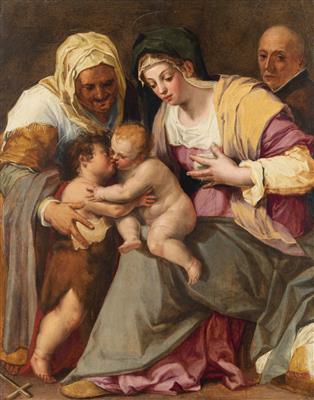Pieter de Witte, called Pietro Candido

(Bruges circa 1540–1628 Munich)
Madonna and Child with Saint Elisabeth, the Infant Saint John the Baptist and a Jesuit (?),
oil on panel, 65 x 51 cm, framed
Provenance:
Federico Zeri Collection, Mentana (Rome);
Private European collection
Literature:
B. Volk-Knüttel, Peter Candid um 1548–1628. Gemälde – Zeichnungen – Druckgraphik, Berlin 2010, p. 119, cat. no. G2, p. 118, ill. 76
The present painting represents a Sacra Conversazione between the Madonna and Saint Elisabeth with the Christ Child and the Infant John the Baptist. Beyond the group, behind the Madonna, there is the figure of a saint, who is probably a member of the Jesuit Order.
The Holy Family was a frequent subject in the work of Pieter de Witte during his Italian period. Another version from this period is conserved in the Alceste Giacomazzi collection in Modena (see op. cit. Volk-Knüttel, 2010, p. 116, cat. G1). In the present painting, there is greater refinement in the descriptions of dress, drapery and the rendering of Saint Elisabeth’s features. This panel is reminiscent of the example that served as inspiration for de Witte’s composition: the Madonna del Divino Amore by Raphael conserved in the Museo Nazionale di Capodimonte, Naples (inv. no. Q146).
The painter, sculptor and architect Pieter de Witte, called Pietro Candido in Italy, was born in Bruges between 1540 and 1548. During the 1560s he was in Florence where he worked in the studio of Giorgio Vasari with whom he collaborated on various Medici commissions. Alongside Vasari he journeyed to Rome where he was exposed to the latest developments of the Tuscan-Roman Mannerists and after a brief stay in Volterra he moved to Munich in 1586. For the next forty-two years, until his death in 1628, he remained there as court painter to Duke William V and then Maximillian I. De Witte’s works were influenced by the forms and colouring of Tuscan Mannerism and it is due to him that a taste for this style penetrated the Bavarian court and contributed to an influence in the artistic output of the region.
30.04.2019 - 17:00
- Dosažená cena: **
-
EUR 25.300,-
- Odhadní cena:
-
EUR 20.000,- do EUR 30.000,-
Pieter de Witte, called Pietro Candido
(Bruges circa 1540–1628 Munich)
Madonna and Child with Saint Elisabeth, the Infant Saint John the Baptist and a Jesuit (?),
oil on panel, 65 x 51 cm, framed
Provenance:
Federico Zeri Collection, Mentana (Rome);
Private European collection
Literature:
B. Volk-Knüttel, Peter Candid um 1548–1628. Gemälde – Zeichnungen – Druckgraphik, Berlin 2010, p. 119, cat. no. G2, p. 118, ill. 76
The present painting represents a Sacra Conversazione between the Madonna and Saint Elisabeth with the Christ Child and the Infant John the Baptist. Beyond the group, behind the Madonna, there is the figure of a saint, who is probably a member of the Jesuit Order.
The Holy Family was a frequent subject in the work of Pieter de Witte during his Italian period. Another version from this period is conserved in the Alceste Giacomazzi collection in Modena (see op. cit. Volk-Knüttel, 2010, p. 116, cat. G1). In the present painting, there is greater refinement in the descriptions of dress, drapery and the rendering of Saint Elisabeth’s features. This panel is reminiscent of the example that served as inspiration for de Witte’s composition: the Madonna del Divino Amore by Raphael conserved in the Museo Nazionale di Capodimonte, Naples (inv. no. Q146).
The painter, sculptor and architect Pieter de Witte, called Pietro Candido in Italy, was born in Bruges between 1540 and 1548. During the 1560s he was in Florence where he worked in the studio of Giorgio Vasari with whom he collaborated on various Medici commissions. Alongside Vasari he journeyed to Rome where he was exposed to the latest developments of the Tuscan-Roman Mannerists and after a brief stay in Volterra he moved to Munich in 1586. For the next forty-two years, until his death in 1628, he remained there as court painter to Duke William V and then Maximillian I. De Witte’s works were influenced by the forms and colouring of Tuscan Mannerism and it is due to him that a taste for this style penetrated the Bavarian court and contributed to an influence in the artistic output of the region.
|
Horká linka kupujících
Po-Pá: 10.00 - 17.00
old.masters@dorotheum.at +43 1 515 60 403 |
| Aukce: | Obrazy starých mistrů |
| Typ aukce: | Salónní aukce |
| Datum: | 30.04.2019 - 17:00 |
| Místo konání aukce: | Wien | Palais Dorotheum |
| Prohlídka: | 20.04. - 30.04.2019 |
** Kupní cena vč. poplatku kupujícího a DPH
Není již možné podávat příkazy ke koupi přes internet. Aukce se právě připravuje resp. byla již uskutečněna.
